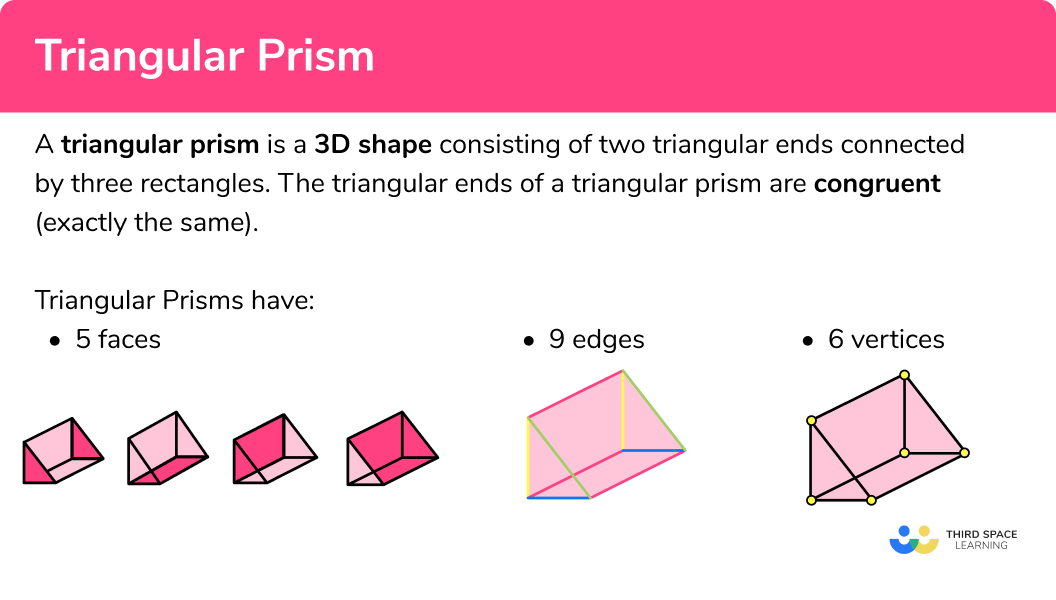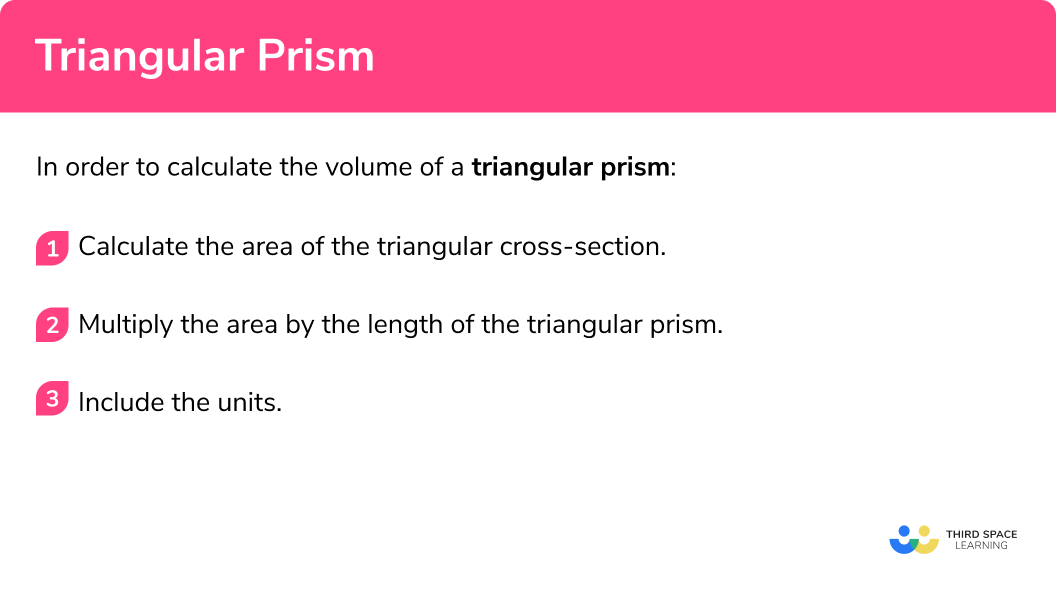One to one maths interventions built for KS4 success
Weekly online one to one GCSE maths revision lessons now available
In order to access this I need to be confident with:
3D shapes Area of a triangle Area of a rectangle Substituting into formulaeThis topic is relevant for:

Triangular Prism
Here we will learn about triangular prisms, including nets of triangular prisms and volume and surface area of triangular prisms.
There are also triangular prism worksheets based on Edexcel, AQA and OCR exam questions, along with further guidance on where to go next if you’re still stuck.
What are triangular prisms?
A triangular prism is a polyhedron (3D shape made from polygons) consisting of two triangular ends connected by three rectangles. The triangular ends of a triangular prism are congruent (exactly the same).
E.g.
What are triangular prisms?

Faces
A face of a 3D shape is a flat surface.
Triangular prisms have a total of 5 faces – 2 triangular faces and 3 rectangular faces. The triangular faces of a triangular prism are congruent.
Edges
An edge of a 3D shape is a straight line between two faces.
Triangular prisms have 9 edges:
Vertices
A vertex is a point where two or more edges meet.
Triangular prisms have 6 vertices:
Nets
A net of a three-dimensional shape is the 2 dimensional shape it would make if it were unfolded and laid flat. Nets can be folded up to make the 3D shapes.
Labelling a triangular prism
We can label the vertices (corners) of a prism to help us identify certain edges or faces.
E.g.
Using this labelling we can identify lengths,
E.g. the length AB:
We can also identify faces,
E.g. the face ABC:
Volume of a triangular prism
The volume of a triangular prism is how much space there is inside of the shape.
To calculate the volume of a triangular prism we find the area of the triangular cross-section and multiply it by the length of the prism (or height of the prism).
\text{Volume of a triangular prism } = \text{ Area of triangular cross section } \times \text{ length}E.g.
Find the volume of the right triangular prism (so called because the triangular faces include a right angle.
Volume is measured in cubic units (e.g. mm^3, \ cm^3, \ m^3 etc).
Step-by-step guide: Volume of a triangular prism
How to calculate the volume of a triangular prism
- Calculate the area of the triangular cross-section.
- Multiply the area by the length of the triangular prism.
- Include the units.
Triangular Prism worksheet
Get your free triangular prism worksheet of 20+ questions and answers. Includes reasoning and applied questions.
COMING SOONTriangular Prism worksheet
Get your free triangular prism worksheet of 20+ questions and answers. Includes reasoning and applied questions.
COMING SOONVolume of a triangular prism example
Work out the volume of the triangular prism
- Calculate the area of the triangular cross-section.
The base of the triangle is 10 \ cm .
The height of the triangle is 4 \ cm.
The area formula for a triangle is:
\begin{array}{l} \text{Area of triangle }=\frac{1}{2} \times b \times h\\\\ \text{Area of triangle }=\frac{1}{2} \times 10 \times 4\\\\ \text{Area of triangle }=20 \end{array}2Multiply the area by the length of the triangular prism.
The volume formula is:
\begin{aligned} &\text{Volume of triangular prism } = \text{ Area of triangular cross section } \times \text{ length} \\\\ &\text{Volume of triangular prism } = 20 \times 15 \\\\ &\text{Volume of triangular prism } = 300 \end{aligned}3Include the units.
The measurements on this triangular prism are in cm so the volume will be measured in cm^3 .
Volume = 300 \ cm^3
Surface area of a triangular prism
The surface area of a triangular prism is the total area of all of the faces.
To work out the surface area of a triangular prism, we need to work out the area of each face and add them all together.
Lateral faces are all of the faces of an object excluding the top and the base. For a triangular prism the top and the base are triangles and the lateral faces are rectangular sides. The lateral surface area is the total area of the rectangular sides
The triangular faces of a triangular prism are congruent (exactly the same) but, unless the triangle is an isosceles triangle or an equilateral triangle, the rectangles are all different.
E.g.
Total surface area =168\; cm^2
Since it is an area, surface area is measured in square units (e.g. mm^2, \ cm^2, \ m^2 etc).
Step-by-step guide: Surface area of a triangular prism
How to calculate the surface area of a triangular prism
- Work out the area of each face.
- Add the five areas together.
- Include the units.
How to calculate the surface area of a triangular prism

Surface area of a triangular prism example
Work out the surface area of the triangular prism
- Work out the area of each face.
2 Add the five areas together.
24+24+24+32+40=1443Include the units.
The measurements on the triangular prism are in mm therefore the total surface area of the triangular prism = 144mm^2 .
Common misconceptions
- Missing/incorrect units
You should always include units in your answer.
Volume is measured in units cubed (e.g. mm^3, \ cm^3, \ m^3 etc).
Surface area is measured in units squared (e.g. mm^2, \ cm^2, \ m^2 etc)
- Calculating with different units
You need to make sure all measurements are in the same units before calculating volume.
E.g. You can’t have some measurements in cm and some in m
- Using the wrong formula
Be careful to apply the correct prism related formula to the correct question type.
- Calculating volume instead of surface area
Volume and surface area are different things – volume tells us the space within the shape whereas surface area is the total area of the faces. To find surface area, work out the area of each face and add them together
- Using the wrong measurements to work out the area of the triangle faces
In surface area questions, we need to know all three side lengths of the triangle however we only need the base and the height to calculate the area of the triangle.
Practice triangular prism questions
1. Work out the volume of the triangular prism




\begin{aligned} \text{Volume of triangular prism }&=9 \times 8\\\\ &=72\mathrm{cm}^{3} \end{aligned}
2. Work out the volume of the triangular prism. Give your answer in mm^3




Notice that we have measurements in mm and cm. We can convert the measurements in cm to mm.
1cm = 10mm, 1.1cm = 11mm
Now we can work out the volume:
\begin{aligned} \text{Area of triangle }&=\frac{1}{2} \times 10 \times 11\\\\ &=55 \end{aligned}
\begin{aligned} \text{Volume of triangular prism }&=55 \times 6\\\\ &=330 \mathrm{mm}^{3} \end{aligned}
3. The volume of this prism is 96 \; cm^2. Work out the height, h , of the prism.




\begin{aligned} \text{Volume of triangular prism }&=2h \times 8\\\\ 96 &= 16h\\\\ 6&=h \end{aligned}
The height is 6cm.
4. Work out the surface area of the triangular prism




Work out the area of each face:
\begin{aligned} &\text{Face} \quad \quad \quad \quad \quad \quad \quad \quad \text{Area} \\\\ &\text{Front} \quad \quad \quad \quad \quad \quad \frac{1}{2} \times 8 \times 6 = 24 \\\\ &\text{Back} \quad \quad \quad \quad \quad \quad \quad \quad \; 24 \\\\ &\text{Bottom} \quad \quad \quad \quad \quad \quad 13 \times 8=104\\\\ &\text{Left side} \quad \quad \quad \quad \quad \; 13 \times 6=78\\\\ &\text{Right side} \quad \quad \quad \quad \;\;\; 13 \times 10=130 \end{aligned}
\text{Total surface area }=24+24+104+78+130=360\mathrm{m}^{2}
5. Work out the surface area of the triangular prism




Work out the area of each face:
\begin{aligned} &\text{Face} \quad \quad \quad \quad \quad \quad \quad \quad \text{Area} \\\\ &\text{Front} \quad \quad \quad \quad \quad \quad \frac{1}{2} \times 5 \times 5 = 12.5 \\\\ &\text{Back} \quad \quad \quad \quad \quad \quad \quad \quad \; 12.5 \\\\ &\text{Bottom} \quad \quad \quad \quad \quad \quad 9 \times 7.1=63.9\\\\ &\text{Left side} \quad \quad \quad \quad \quad \; 9 \times 5=45\\\\ &\text{Right side} \quad \quad \quad \quad \;\;\; 9 \times 5=45 \end{aligned}
\text{Total surface area }=12.5+12.5+63.9+45+45=178.9\mathrm{cm}^{2}
6. Work out the surface area of the triangular prism. Give your answer in cm^2.




Notice that we have measurements in cm and m. We have been asked for the answer in cm^2 so we need to convert m to cm:
1.5m=150cm.
Now we can work out the area of each face:
\begin{aligned} &\text{Face} \quad \quad \quad \quad \quad \quad \quad \quad \text{Area} \\\\ &\text{Front} \quad \quad \quad \quad \quad \quad \frac{1}{2} \times 60 \times 35 = 1050 \\\\ &\text{Back} \quad \quad \quad \quad \quad \quad \quad \quad \; 1050 \\\\ &\text{Bottom} \quad \quad \quad \quad \quad \quad 150 \times 60=9000\\\\ &\text{Left side} \quad \quad \quad \quad \quad \; 150 \times 35=5250\\\\ &\text{Right side} \quad \quad \quad \quad \;\;\; 150 \times 69.5=10425 \end{aligned}
\text{Total surface area }=1050+1050+9000+5250+10425=26775\mathrm{cm}^{2}
Triangular prisms GCSE questions
1. Work out the volume of the triangular prism
(2 marks)
(1)
\text{Volume of triangular prism: } 70 \times 20 = 1400 \mathrm{mm}^{3}
(1)
2. (a) Which of these is a net of a triangular prism?
(b) What would the surface area of the triangular prism be?
(3 marks)
(a) A
(1)
(b)
\text{Triangles: } \frac{1}{2} \times 3 \times 4 = 6 \mathrm{cm}^{2}
(1)
\text{Rectangles: } 12 \times 5 =60, 12 \times 4 = 48, 12 \times 3 = 36
(1)
\text{Surface area: }6+6+60+48+36=156\mathrm{cm}^{2}
(1)
3. This triangular prism has a volume of 300cm^3. Work out the surface area of the prism.
(5 marks)
(1)
300=30 \times \text{length}
(1)
\text{length } =10cm
(1)
\text{Surface area }= 30+30+50+120+130
(1)
\text{Surface area }=360\mathrm{cm}^{2}
(1)
Learning checklist
You have now learned how to:
- Recognise a triangular prism
- Calculate the volume of a triangular prism
- Calculate the surface area of a triangular prism
- Apply formulae to calculate and solve problems involving triangular prisms
- Use the properties of faces, surfaces, edges and vertices to solve problems in 3-D
The next lessons are
Still stuck?
Prepare your KS4 students for maths GCSEs success with Third Space Learning. Weekly online one to one GCSE maths revision lessons delivered by expert maths tutors.

Find out more about our GCSE maths tuition programme.